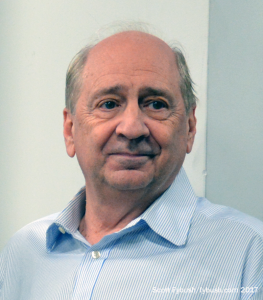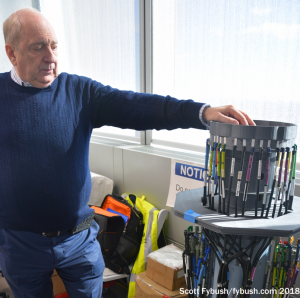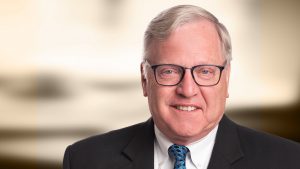NorthEast Radio Watch 12/8/2025: Cichon’s Back in Buffalo
In this week’s issue… Veteran newsman returns - Remembering NY's Leitner, RI's Jones - CT AM saved - Maine AM moves - "Indie" adds suburban signals
In this week’s issue… A giant of NYC broadcasting is gone – Remembering Robert FX Sillerman – Standard grows in Southern Tier, beyond – WPEN PD out – 100 years of radio in Montreal
By SCOTT FYBUSH
*If you’re one of the 18 million or so people who listen to FM radio or watch TV in greater NEW YORK in the 21st century, you can thank John Lyons for making it possible.
Lyons, who died Friday, did more than any other single engineer to shape the physical form of New York broadcasting through his work at all three of the major sites in Manhattan, first at the Empire State Building, then at 4 Times Square, and then most notably as the mastermind who returned television to the rebuilt 1 World Trade Center in the long years after 9/11.
 His broadcast life began (as did so many New Yorkers’) at Brooklyn Tech, then continued with work at WRFM (105.1) and WWRL (1600). While at WWRL, he also moonlighted in the Caribbean, building ZDK in Antigua and serving as its chief operator. From there, it was off to Manhattan and WOR (710), as assistant chief engineer, then sister station WXLO (98.7), where he spent a decade as chief engineer.
His broadcast life began (as did so many New Yorkers’) at Brooklyn Tech, then continued with work at WRFM (105.1) and WWRL (1600). While at WWRL, he also moonlighted in the Caribbean, building ZDK in Antigua and serving as its chief operator. From there, it was off to Manhattan and WOR (710), as assistant chief engineer, then sister station WXLO (98.7), where he spent a decade as chief engineer.
His work at WXLO brought him into the orbit of the Master FM committee at Empire, where he was a key part of the planning that led to the early 1990s move from the Alford master antenna to the new ERI master antenna a few hundred feet higher up on the mast. By then, Lyons had moved on to new roles, first with DSI Communications, then with Sony Worldwide as it built out its new radio network.
He came back to radio, and to Empire, at Viacom’s WLTW (106.7) and then as chief engineer of new sister station WAXQ (104.3), a role he retained while once again chairing the Empire FM committee. In the early 2000s, with WAXQ and WLTW now part of a larger Clear Channel cluster, Lyons led the charge to build out a new auxiliary site for all five FMs in the group.
That’s where I first met him, in the early spring of 2001. As a new writer for Radio World, I made my first visits to the Empire transmitter rooms and to John’s brand-new auxiliary site a few blocks away, on a short tower atop the 4 Times Square office tower, among the first significant new skyscrapers to go up in Manhattan in more than a decade.
“Next time you come visit,” he said as we parted, “I’ll take you down to the World Trade Center to see WKTU,” the lone Clear Channel FM that was then broadcasting from downtown.
There was never a next time, of course. On 9/11, Lyons’ careful planning paid off: in the midst of the tragedy, WKTU’s signal smoothly switched to 4 Times Square, one of just two WTC signals that had a substantial aux site ready to go. (The other, WCBS-TV, had retained space at Empire only by accidentally failing to cancel a lease.)
Within a few months, Lyons was already at work planning out a much more robust auxiliary site. He left Clear Channel in 2002 to join the Durst Organization, the owner of 4 Times Square, where he plotted out the replacement of the original 143-foot tower with a 385-foot tower carrying enough antenna capacity for most of the New York TV and FM dial. Other broadcasters, including Univision, ABC, WNYE, WKCR, SBS and WNYC, joined that project over the next few years.
Then came Lyons’ crowning achievement: Durst became involved with the new 1 World Trade Center tower, putting John at the center of the New York TV world. While the new 1WTC wasn’t an appealing prospect for FM stations for a variety of spacing and height reasons, it was a natural spot for TV broadcasters to relocate.
 As a newly-minted vice president at Durst, it was Lyons’ responsibility to design the new 1WTC facility from the ground (or at least the 98th floor) up. What did the antennas need to look like? How would a 21st century transmitter room be laid out? And, of course, who would occupy that room and who would choose to stay uptown at the Empire State Building as that venerable facility also rebuilt itself for 21st century broadcasters?
As a newly-minted vice president at Durst, it was Lyons’ responsibility to design the new 1WTC facility from the ground (or at least the 98th floor) up. What did the antennas need to look like? How would a 21st century transmitter room be laid out? And, of course, who would occupy that room and who would choose to stay uptown at the Empire State Building as that venerable facility also rebuilt itself for 21st century broadcasters?
John Lyons shone in his new role at Durst. He learned the commercial real estate business as he took on Durst’s end of the negotiations with America’s biggest broadcasters – and he landed nearly all of them for 1WTC. CBS, NBC, Fox, WNET and Ion all signed on for the new building. On half of a high floor just below the public observation deck, Lyons built out a transmitter room like few others in North America: with highly reliable transmitters, there was little need for full-time engineers or even separate rooms. Instead, he designed what looked like a data center with the world’s most spectacular view out the (usually shaded) windows: a row of racks for each station on one side, a pair of combiners on the other feeding a pair of antennas up above.
The combiners and the antenna were another complex dance of the sort John excelled at: he traveled to Australia to oversee design and construction at RFS, planning from the beginning for the 2019 repack work that would require almost every station feeding the combiners and antennas to change frequency. As ever, it was planned to the tiniest detail with John at the helm, and it went off without a hitch.
How could I possibly have known, when I last saw John up at 1WTC a year or so ago, that it would be the last of his great projects? John suffered a heart attack over the Thanksgiving holiday, we’re told, and was gone suddenly on Friday, at just 71.
Read on for a few more personal recollections of John.

As we announced a few weeks ago, the 2026 edition of the Tower Site Calendar will be the last.
We began publishing it 25 years ago, and the broadcast landscape is radically different now.
Radio World just ran an excellent article about us if you want to know more.
Once it’s gone, that’s it. We won’t be printing any more.
Thank you to everyone who saw our announcement and rushed to buy it. We appreciate you.
(There are some calendars from previous years if you want more of a tower photo fix — all under $5.)
But don’t wait to get this year’s Tower Site Calendar — buy it now!
We are selling the Broadcast Historian’s Calendar again this year, but we have that in an even smaller quantity — definitely don’t hesitate for that.
And visit the Fybush Media Store to check out our selection of books and videos, too!
*It’s my column, and so I’ll take a rare opportunity to share some of my own personal thoughts here first.
Once you had John’s trust, you always had his trust. As his busy schedule allowed, he was always happy to take the time to show off the latest state of his current projects whenever I’d visit the city. He moved through his native New York even faster than I usually do, and yet somehow delighted in every detail of the city. On that first visit to Empire in 2001, riding up to the 80th floor in the elevator with the tourists, he had memorized most of the recorded greetings in a dozen different languages that played in the cab on the ride up. Moving through Times Square on the way to 4TS, he brushed past the ever-present tourist jams, more than once pulling me out of the path of oncoming traffic.
He became a family man late in life, marrying a woman he’d met in Siberia while attending a ballroom dance competition. When I first got to know him, his son Matthew was in school, which meant every visit began with half an hour of fatherly pride about Matthew’s latest big accomplishments (and there were many!). Still later, there was a second son, Constantine, now 7.
And he was a tremendously funny, friendly human being, delighting over the years in watching my hairline recede to about the same level of baldness he long boasted. As a family man, he loved showing off his unique vantage points to anyone who was visiting town; over the years, his guests up at 4 Times Square included my dad and my then-infant daughter, who somehow ended up on the roof inside a hard hat.
Our first meeting, back in 2001, ended with a promise he was never able to keep, a visit to the old 1WTC. Somehow, over the years, we were never able to coordinate getting me up on the roof of the new 1WTC, either. It’s fitting, perhaps, that my last visit to his transmitter room there also ended with a promise – “next time you come up, they’ll be done working on the elevator and we’ll go up there.”
I’ll never get there with John now. (And who could possibly fill his shoes at Durst, with that unique combination of engineering, logistical, business and real estate savvy he brought to the job?) But I will never, ever stop looking up at the top of John’s building and remembering the way this incredible man willed this project into being.
He won all the awards you’d expect him to have won, of course, from all the usual industry associations he was involved in, including the AFCCE, SBE, NAB and others. But it’s that transmitter site 1776 feet above lower Manhattan that is, and should be, his real monument.
*Meanwhile, one of John’s former broadcast haunts was part of a stealthy ownership shuffle last week. The former WRKS, now WEPN-FM (98.7), is one of two Emmis-owned stations that stays fully with Emmis after the sale of two other New York signals to the new Mediaco Holdings.
Emmis also keeps WLIB (1190), while WQHT (Hot 97) and WBLS (107.5) go from Emmis ownership to Mediaco, which is controlled by Soohyung Kim’s Standard General. Emmis keeps a 23.72% stake in Mediaco and will continue to operate WQHT and WBLS under a shared services agreement. In exchange for giving up the rest of its interest in WQHT and WBLS, Emmis gets a cash infusion of $91.5 million, plus another $5 million as a note.
What changes for listeners? Nothing at all, at least not right away. WQHT and WBLS will stay in place at Emmis’ Hudson Street studios, run by existing management and with no change in employees. Emmis CEO Jeff Smulyan will also serve as Mediaco’s CEO. WLIB, which has been on the market for a while now, is presumably still for sale at the right price, which may eventually pull it free of Emmis – and WEPN-FM, of course, is operated by Disney/ESPN under a long-term LMA, so it has little to do with Emmis on a day-to-day basis.
![]() *Another “Standard” company was also in the news last week. Standard Media already has a small toehold in the region in RHODE ISLAND, where it’s owned ABC affiliate WLNE (Channel 6) for the last few years. Now it’s paying $59.2 million to pick up nine TV stations and 15 radio stations from the investment group that owns Vision Communications and Waypoint Media.
*Another “Standard” company was also in the news last week. Standard Media already has a small toehold in the region in RHODE ISLAND, where it’s owned ABC affiliate WLNE (Channel 6) for the last few years. Now it’s paying $59.2 million to pick up nine TV stations and 15 radio stations from the investment group that owns Vision Communications and Waypoint Media.
As you’d expect from a deal of that size, it’s mostly about the TV stations, a motley cluster of small-market network affiliates in places such as Lafayette, Indiana, Jonesboro, Arkansas and Jackson, Tennessee, where Waypoint has been filling out network affiliate rosters with low-budget LPTV and full-power signals.
But it’s also a radio deal in several Southern Tier markets. Here’s what Standard gets from Sound Communications as its first radio holdings: in Elmira/Corning, it picks up Fox affiliate WYDC (Channel 48) and MyNetwork affiliate WJKP-LP (Channel 6), plus a six-station radio cluster. There’s AC “Magic” WENI-FM (92.7 South Waverly)/WENY-FM (97.7 Big Flats), classic hits “Gem” WGMM (98.7 Corning), country WKPQ (105.3 Hornell) and the talk duo of WENY (1230 Elmira)/WENI (1450 Corning). And down the road in Olean, it’s country “The Ride” WZKZ (101.9 Alfred)/WOEN (1360 Olean plus 96.3 translator), rock WQRS (98.3 Salamanca), top-40 “Mix” WMXO (101.5 Olean) and talk WGGO (1590, plus 100.5 translator).
Will Standard keep the radio stations in the Southern Tier and in Lafayette, Indiana, or will another spin be in the works? And where else will Standard look to expand its TV holdings, as it fights for whatever crumbs are left now that bigger players like Gray, Tegna and Nexstar have picked over most of the larger clusters.
*A call change in Buffalo: the former Family Stations outlet, WFBF (88.9), becomes WBKV as it changes hands to EMF as a new K-Love outlet.
*In Albany, David Oldread starts Wednesday as GM/market manager of Pamal’s Albany Broadcasting cluster. Oldread had been sales and operations director for Entercom’s WEEI network stations in Springfield/Worcester/Providence; at Pamal, he replaces the departed A.J. Bodden.
*John Lyons, as it turns out, wasn’t the only significant name in New York broadcasting history who died this past week. Robert F.X. Sillerman, who died Nov. 24, also at 71, was probably better known in the larger broadcasting world outside engineering, and for good reason – he was a major player in deal after deal for more than 30 years, starting at age 30 when he partnered up with “Cousin Brucie” Morrow under the Sillerman-Morrow Broadcasting banner.
From an early, motley set of small-market holdings that included WRAN (1510 Dover, NEW JERSEY), WALL/WKGL in Middletown and WJJB in Hyde Park, the company grew into New England, adding WPLR in New Haven, CONNECTICUT and WHMP AM-FM Northampton and WCOD on Cape Cod, Mass.
By the mid-1980s, Sillerman, a Brandeis University graduate, was playing in bigger markets, partnering with Carl Hirsch to acquire much of the former Metromedia group, including WNEW (1130) and WNEW-FM (102.7) in New York and WMMR (93.3) in Philadelphia. The former Metromedia FMs eventually became Legacy Broadcasting, which Sillerman and Hirsch spun to Group W in 1989 for $727 million.
Sillerman’s next acts were even bigger: he jumped back into radio ownership in the consolidation era with SFX Broadcasting, which grew to more than 70 stations in markets that included Providence and Hartford before being acquired by Capstar in 1997, forming much of the foundation of what would eventually become Clear Channel and then iHeart Media.
Sillerman had begun acquiring concert promotion businesses by then under the SFX umbrella; he kept those after selling radio, then sold that business to Clear Channel in 2000, creating what’s now known as Live Nation. (A newer version of SFX Entertainment had been in business in recent years, though much smaller than the original.)
Sillerman had been living in Hinsdale, NEW HAMPSHIRE in recent years, and had reportedly been suffering from a respiratory illness.
 *In western PENNSYLVANIA, Entercom’s KDKA (1020 Pittsburgh) is in search of a new morning co-host to replace 15-year veteran John Shumway. It was probably easier for Shumway to juggle his two jobs back when KDKA radio was co-owned under CBS with KDKA-TV (Channel 2), where he’s also a reporter; in any event, he’s now solely with CBS at the TV station downtown after giving up his radio job at the end of his Nov. 27 show.
*In western PENNSYLVANIA, Entercom’s KDKA (1020 Pittsburgh) is in search of a new morning co-host to replace 15-year veteran John Shumway. It was probably easier for Shumway to juggle his two jobs back when KDKA radio was co-owned under CBS with KDKA-TV (Channel 2), where he’s also a reporter; in any event, he’s now solely with CBS at the TV station downtown after giving up his radio job at the end of his Nov. 27 show.
In Philadelphia, Eric Johnson has exited after two years programming (“director of sports content” was the official title) Beasley’s WPEN (97.5) and WTEL (610). Johnson was best known for his long run at “New Jersey 101.5″ in Trenton before that, but he’d also worked in Philly earlier on at WIP, WPLY and WSNI.
There’s no word yet on where Johnson is headed next, or who might take over at the Beasley cluster.
*”Giant Gene Arnold” was a Broadcast Pioneers of Philadelphia Hall of Fame inductee last year, honoring his work on WIFI, WIBG, WCAU and WZZD in Philadelphia, WEEZ in Chester and WCAM in Camden from the mid-sixties into the 1980s. Arnold was also a record producer and worked in advertising, and he’d been a teen dancer on “American Bandstand” in the late fifties. Arnold, born Arnold Rubin, was 78 when he died Nov. 18.
 *It’s not easy to keep a small local news operation running, and WHAV-LP (97.9) in Haverhill, MASSACHUSETTS is struggling to keep its important work going in what’s otherwise become something of a local news desert. We’ve written before about the work Tim Coco has done to restore the “WHAV” brand in the market, first as a webcast and then on the FM dial in recent years. As the calendar ticked down toward Thanksgiving, it wasn’t clear whether WHAV could continue at all; on Thanksgiving, Coco announced WHAV would go to an all-Christmas format through the holidays as it continues to solicit more listener and community support to continue into 2020. (Stay tuned – I want to get Tim on the “Top of the Tower” podcast with more details about where things stand with this outstanding community-focused operation.)
*It’s not easy to keep a small local news operation running, and WHAV-LP (97.9) in Haverhill, MASSACHUSETTS is struggling to keep its important work going in what’s otherwise become something of a local news desert. We’ve written before about the work Tim Coco has done to restore the “WHAV” brand in the market, first as a webcast and then on the FM dial in recent years. As the calendar ticked down toward Thanksgiving, it wasn’t clear whether WHAV could continue at all; on Thanksgiving, Coco announced WHAV would go to an all-Christmas format through the holidays as it continues to solicit more listener and community support to continue into 2020. (Stay tuned – I want to get Tim on the “Top of the Tower” podcast with more details about where things stand with this outstanding community-focused operation.)
*At Beasley in Boston, Tim Staskiewicz has been promoted to digital PD for all five stations in the cluster, a role he’d already been performing at WBZ-FM (98.5 the Sports Hub) and WKLB (102.5). Staskiewicz came along with WBZ-FM when Beasley acquired the sports station two years ago; he’d been digital content director for CBS Radio in Boston before that.
*There are several obituaries this week from the Merrimack Valley, too. Joseph McDonough went by “Jay” on the air, starting in the 1970s and 1980s when he was “Jay Campbell” on WRKO, then later at WHEB in Portsmouth, N.H. and WROR in Boston. More recently, Jay McDonough was an LPFM broadcaster in his own right, founding WXBJ-LP (94.1 Salisbury), where he could be heard spinning the oldies in morning drive and on weekends. McDonough’s full-time job, for more than four decades, was as a Massachusetts constable. He died Nov. 24, at age 66, after a long battle with cancer of the appendix.
There’s a belated obituary, too, for Hillary Stevens, who grew up in the Philadelphia area but came to Boston to attend Grahm Junior College, birthplace of so many media careers. Best known for modeling and acting, Stevens was also a regular radio voice at many Boston stations, including WEEI, WZLX, WROR, WSSH, WMRE and WRKO; at WRKO, she hosted the “Gardening Show” and met her husband, newsman Bill Rossi. Stevens was living in Billerica when she died Nov. 6, at 82.
*In MAINE, MaineInvests LLC expands up to Bangor with the $100,000 purchase of WCYR (1400 Veazie) and translator W275CQ (102.9 Bangor) from Port Broadcasting. WCYR and the translator have been doing country as “Country Road,” but we’d expect that to change under the new ownership, which is tied in with “Hot 104.7” WHTP in Kennebunkport and oldies WJYE (1280) in Gardiner.
*We’ll be spending a lot of the next eleven months arguing online (and maybe even in the occasional in-person heated conversation) about why KDKA in Pittsburgh didn’t single-handedly invent radio broadcasting on the night of November 2, 1920. When we have that argument, one of the things we’ll be citing will be what happened in CANADA eleven months earlier.
It was on December 1, 1919 in Montreal that Canadian Marconi began broadcasting over station XWA – which means you can argue, if you’d like, that it was really this past weekend that marked another broadcasting centennial.
(We’ll pause here to listen from the West Coast as defenders of “Doc” Herrold remind us that “San Jose Calling,” the antecedent of today’s KCBS San Francisco, was on the air way back in 1909 and we all missed the real centennial by ten years.)
Sadly, the Canadian case for primacy doesn’t come with any big centennial celebration; the station that started as XWA became CFCF 600 for most of its life, then CIQC, then moved to 940 as CINW before fizzling out a few years short of its 100th birthday. So it’s only the historians marking this one, instead of the louder celebration that we’ll be shouting over next November.
While we wait for that (and for WWJ in Detroit to celebrate its centennial earlier in 2020, and for WBZ’s New England radio centennial in the fall of 2021), we turn back to New England and our good friend Art Donahue, formerly of WCVB Boston’s “Chronicle.”
Maybe you remember the amazing love letter Donahue did as a tribute to radio on “Chronicle” a few years back. Now he’s put together an audio piece masquerading as a YouTube video, running us through legal IDs on every available AM frequency he could hear at his home outside Boston.
(And perhaps you’ve seen this video already; it’s been linked widely, but Art was modest enough not to include his credit on it, and he deserves the recognition!)
[/private]
In this week’s issue… Veteran newsman returns - Remembering NY's Leitner, RI's Jones - CT AM saved - Maine AM moves - "Indie" adds suburban signals
In this week’s issue… Scripps stations face takeover - Sinclair moves more affiliations - CT stations sold - Maine AM surrendered - Remembering WVBR's Shapiro, WABC's Morgan
In this week’s issue… CT TV legend succumbs to cancer - Remembering PA's Adams - FCC still stalled by shutdown - Pittsburgh morning host exits
In this week’s issue… FCC faces reopening challenges - Veteran Boston anchor retires - Morning shift in Toronto - NYC FMs expand reach